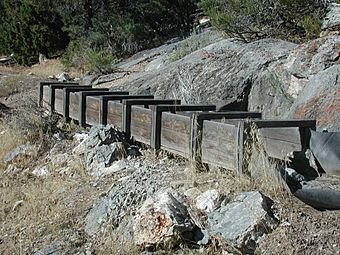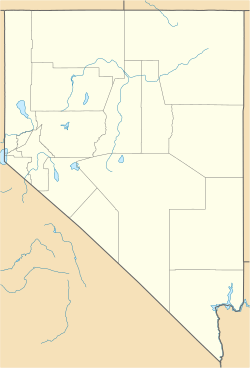Lehman Orchard and Aqueduct facts for kids
Quick facts for kids |
|
|
Lehman Orchard and Aqueduct
|
|
 |
|
| Nearest city | Baker, Nevada |
|---|---|
| Built | 1891 |
| NRHP reference No. | 75000181 |
| Added to NRHP | February 25, 1975 |
The Lehman Orchard and Aqueduct are important historical places found near the Great Basin National Park in eastern Nevada. They were created by a pioneer named Absalom Lehman, who also discovered the famous Lehman Caves in the area. These sites show how early settlers used the land and water to survive and thrive.
Contents
Who Was Absalom Lehman?
Absalom Lehman was a brave pioneer who moved to eastern Nevada in the late 1800s. He was known for discovering the beautiful Lehman Caves, which are now a major attraction in Great Basin National Park. Besides exploring caves, Lehman was also a farmer and a smart builder. He understood how important water was in the dry Nevada landscape.
Settling the Land
Lehman decided to build a home and a farm in this area. He chose a spot where he could use the natural resources around him. His goal was to create a place where he could grow food and live comfortably. This led him to establish the orchard and the special water system.
The Lehman Orchard
The Lehman Orchard was a large fruit farm that Absalom Lehman started. At its biggest, it had over 100 fruit trees! These trees grew many different kinds of fruits.
What Grew in the Orchard?
In the 1930s, the orchard still had about 40 trees. These included apricot, pear, peach, crabapple, plum, and apple trees. Imagine picking fresh fruit right from the tree! Today, only a few of these original trees remain. There are seven apricot trees and one peach tree still growing.
Why Was the Orchard Important?
Growing an orchard in a dry place like Nevada was a big challenge. It showed how determined Absalom Lehman was. The orchard provided fresh food for his family and possibly for others in the area. It was a vital part of his settlement.
The Lehman Aqueduct
To make the orchard grow, Absalom Lehman needed a lot of water. He solved this problem by building an amazing water system called an aqueduct. An aqueduct is like a long ditch or channel that carries water from one place to another.
How the Aqueduct Worked
Lehman built his aqueduct to bring water from Lehman Creek. This creek was about 2 miles (3.2 kilometers) away from the orchard. The aqueduct carried the water directly to the orchard, where it circled around the trees. This clever design made sure every tree got the water it needed to grow.
More Than Just Irrigation
A part of the aqueduct also branched off to a reservoir. A reservoir is a place where water is collected and stored. This reservoir was used for more than just watering the trees. People could use it for making ice, fishing, and even swimming! Sadly, this reservoir is no longer there. However, a part of the aqueduct has been rebuilt so people can see how it worked.
A Historic Landmark
Both the Lehman Orchard and the reconstructed part of the aqueduct are located close to the National Park Service's Lehman Caves Visitor Center. This makes them easy for visitors to see and learn about.
National Register of Historic Places
Because of their importance to history, the Lehman Orchard and Aqueduct were officially recognized in 1975. They were placed on the National Register of Historic Places. This is a special list of places in the United States that are important to the country's history. Being on this list helps protect these sites so future generations can learn from them.



